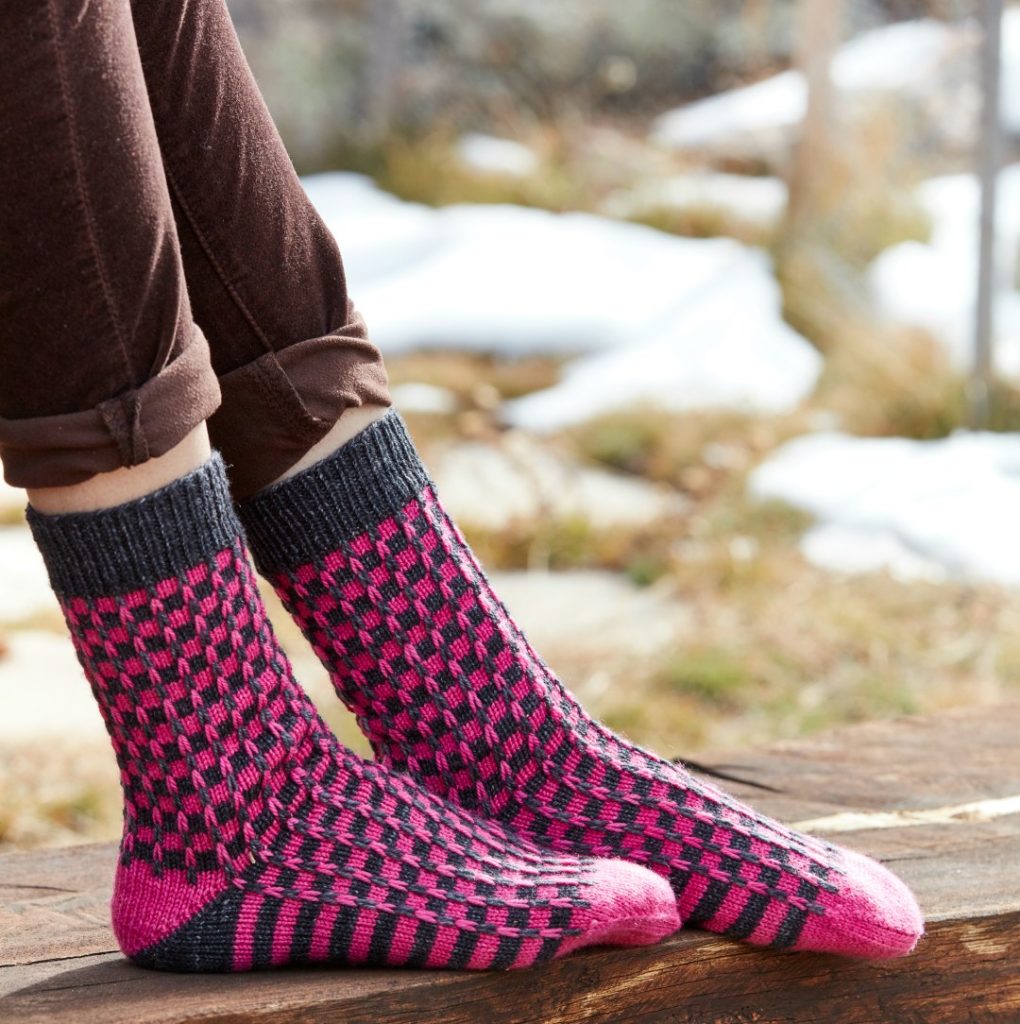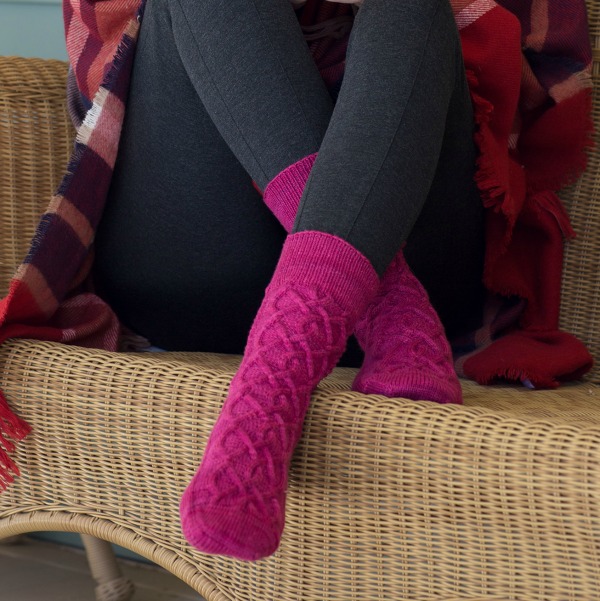Make Your First Knitted Socks

Sock knitting is hugely popular for a variety of reasons. Sock projects are much more portable than sweaters, they’re ideal for gifting, and there are so many wonderful, beautiful, and fun yarns for knitted socks. And it’s not as difficult as it might seem, really! Knitting socks is very straightforward, making them great projects for travel, or knitting at the game or while waiting for the kids to finish their sports practice. As long as you’ve got the right number of stitches and pay attention to the instructions, it will all work out.
Knitting
Socks are nearly always worked in the round. (It is possible to work them flat and seam them, but it’s pretty difficult to make a tidy and comfortable seam.) You can use your choice of knitting style for working in the round: double-pointed needles, magic loop, or two circular needles. (There are even tiny 8- to 9-inch circular needles, although you will still need one of the other methods to finish the toe.) And the needles are usually small: size 1 or 2 (2.25–2.75 mm). Knit your socks at a tight gauge to make them hardy and resilient.
Yarn
When making socks, look for purpose-made yarns. Socks need to withstand a lot more wear than anything else you’ll ever make, so the yarn needs to be hard-wearing! Yarns designed for sock knitting are tightly twisted with multiple plies. The tight twist prevents pilling and fraying, and multiple plies make the yarn stronger.

Socks are usually made with fine yarn known as sock- or fingering-weight yarn. (These are socks that you’ll be able to fit into your shoes.) But not all fingering-weight yarns are sock yarns; some of them are intended for shawls or fine garments and are more delicate. Make sure to read the label and look at the yarn to find something suitable.
Although it’s tempting to buy yarns that feel deliciously soft in your hands, softness is not your friend for socks: the softer the yarn, the faster it will pill and look worn. You don’t want to make socks of yarn that makes you itch, but choose something that feels hardy and substantial.
I prefer wool for sock knitting; it’s warm and insulating, and it also breathes well so you don’t get sweaty feet. Wool wicks moisture away, meaning that wet socks dry quickly. And wool stretches out as you wear it but bounces back when you wash it. The best wool sock yarns have a little nylon blended into them to add strength. If you’re making socks for someone who can’t wear wool, choose a yarn that has some elastic blended into it for a better fit: my preferred nonwool sock yarn is cotton and bamboo blended with elastic.

Fit
Just like the ones you buy in the store, socks should stretch to fit. Specifically, a sock should be worn with negative ease, which means that the sock circumference should be slightly smaller than your foot. This is so that the sock stays up on your leg and stays in place in your shoes. Floppy socks are uncomfortable, and they wear out faster! A fingering-weight sock should be about 10% smaller around than your foot—for most adult socks, this difference is about an inch. For heavier yarns, knit them with a little less negative ease—that is, a little closer to your foot circumference.
To determine which size sock to make, measure the circumference around the ball of your foot. (For adults, it’s usually in the range of 8 to 10 inches.) For a fingering-weight sock, subtract an inch from that number to get the size of sock you need. Look for sock patterns that offer multiple sizes to make sure you get the fit you need; although “one size fits all” works for store-bought socks, handknitted fabric is different, and your feet will be happier and your socks will last longer if you get the right fit.
Sock Construction
Socks can be worked from the cuff down to the toe, or from the toe up to the cuff. Once you have a bit of experience, they’re about the same level of difficulty; however, for beginners, I suggest starting with top-down socks. Casting on for a toe-up sock can be fiddly, whereas if you start with the cuff, you’ve got a straight section through the leg to help build your confidence with the yarn and needles before you start the shaping.

No matter which direction they’re worked, there are two basic types of heels, each with variations: a short-row heel and a flap-and-gusset heel. The short-row heel looks most like a store-bought sock. However, because the fabric of store-bought socks is different from handknitted fabrics, this style doesn’t always fit very well. I find that handknitted socks generally fit better if they have a flap-and-gusset construction. Most people’s feet are larger in circumference just in front of the heel, so you need more fabric at that point. The flap-and-gusset construction adds a bit of extra circumference for a more comfortable fit. Try both methods to determine which heel type works best for you.

There are also two basic approaches to the toe: a straight-top toe and a curvy toe. The straight toe is more traditional; in a top-down sock, the toe is shaped with decreases on each side of the sole and closed using Kitchener stitch. Although it does look very tidy, the grafting is a bit tricky. I prefer to use a curvier toe; instead of grafting the toe closed, the yarn tail is threaded through the stitches and cinched closed, like the top of a hat. I find that fits my feet better—and it’s easier! I used this method for my Simple Camping Socks.
One of the wonderful things about sock knitting is that it can be as simple or as challenging as you like. Once you’ve mastered a standard pattern, you make it over and over again. I find knitting plain socks with fun yarns very relaxing. Or if you’re up for a challenge, there are all sorts of patterns and variations. Sock knitters all have their preferences: which needles to use, which yarn they prefer, the construction they find easiest, which heel and toe variations fit them best. Once you’ve tried your first sock pattern, you’ll be well equipped to try others and form your own opinions!
Happy sock knitting!
Kate
(Originally posted on July 12, 2018; updated on July 18, 2019.)












Love the site!!
Love the site!!